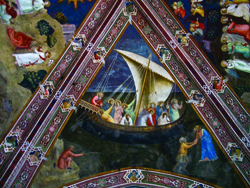Fresco is one of the most fascinating and most diffused artistic techniques in central and southern Italy. The fresco technique was big in the classical period; the Minoans, Greeks and Romans decorated their grand homes with wall paintings in fresco…
 During the medieval period this technique, like bronze for artistic purposes, dropped out of use, only to flourish again in the 1300s in the wealthy city states of Italy. Florence led the way in the technique’s revival and perfection.
During the medieval period this technique, like bronze for artistic purposes, dropped out of use, only to flourish again in the 1300s in the wealthy city states of Italy. Florence led the way in the technique’s revival and perfection.
The technique’s name (fresh, in English), refers to the fact the artists are painting onto freshly laid plaster.
Their image will dry with the drying of the actual wall plaster upon which it was painted, and so the work becomes part of the wall, not simply on the wall. This creates a more durable, longer lasting work than simple mural painting; however, not without crippling time constraints. The artisan only has the time to paint that the plaster has to dry, so one must work very quickly, and of course flawlessly, because once dry, there is no room for second thoughts and changes.
Fresco is favourable when covering large spaces (ceilings, chapels, inside and outside walls), as it is very cost effective. You only need colour pigment and the ingredients for the plaster (lime, sand, water) – much cheaper than all the materials needed, and preparation required, for panel and canvas painting. However, if a mistake is made, then the plaster needs to be taken off and re-laid and the work done again.
 Of course, many times this was not always what happened and paint was applied over the mistake, however, the fresco secco technique (dry fresco) will not stand the test of time quite as well as the underlying fresco buono (good, or true, fresco). Due to the size of many frescoes and the increased complexity of the subject matter and scene content from the 1400s onwards, the artisans do a very little section each day. This daily section is called giornata, from the Italian word daily. The artisan chooses what he believes he can colour in one day’s work and lays the plaster only on that particular section. One fresco is made up of many separate daily plastered parts, many different giornate.
Of course, many times this was not always what happened and paint was applied over the mistake, however, the fresco secco technique (dry fresco) will not stand the test of time quite as well as the underlying fresco buono (good, or true, fresco). Due to the size of many frescoes and the increased complexity of the subject matter and scene content from the 1400s onwards, the artisans do a very little section each day. This daily section is called giornata, from the Italian word daily. The artisan chooses what he believes he can colour in one day’s work and lays the plaster only on that particular section. One fresco is made up of many separate daily plastered parts, many different giornate.
Finally, the artists must work in colour blocks to be certain that they achieve a tonal consistency. There is a chemical reaction which occurs between the pigment and lime during the drying process, and it is during this phase that the true shade is established. Of course, this means that one can never be sure of being able to reproduce the identical shade of colour from one day to the next as the drying time, and hence chemical reaction, is dependent upon the atmospheric conditions.
Understanding this ancient technique, it arouses even more wonder when looking at the amazingly detailed frescoes scattered around Italy with their smooth and consistent surfaces, even though they were done in separate blocks and with no second chance.
